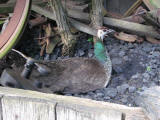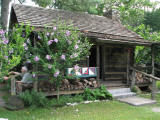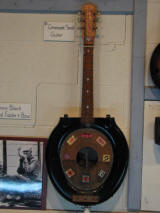![]()
Smoky Mountain Rail Tour
June, 2009
Part 4: Hiwassee Loop Railroad, Museum of Appalachia, Rugby
 |
 |
 |
 |
| Terry and James (from Ireland) relaxing after a big lunch in Etowah, Tennessee. James is a Professor of Electrical Engineering. I asked him my usual question: "Big Electrons, or Little?" He said "little", meaning he specializes in electronics and low voltage devices, rather than high voltage and electrical distribution. | A sign in the museum at the rail depot in Etowah. This could apply to any town in economic transition - timber towns of the Northwest, steel cities in America's "rust belt", Detroit today, Seattle in the "last person to leave, turn off the lights" days of Boeing contraction. | The Hiwassee Loop train loads in the middle of the woods in a Tennessee State Park. Our bus has dropped us off at the rail crossing for boarding. | We follow the Hiwassee River, passing the Apalachia (spelled with just one "p") power generation station on the way up. This is TVA country, where hydroelectric facilities are just as common as they are in the BPA territory out West. |
 |
 |
 |
 |
| The highlight of this trip is the loop around Bald Mountain, where the rail line crosses over itself to gain elevation. The loop replaced two switchbacks on the original line. Here we're passing underneath the tracks we'll be on shortly as we wind our way up the mountain...,. | ...As we circle Bald Mountain, we can see the tracks below us... | ...and now we cross the trestle and can see the tracks below us. | On our way down the hill, we encounter a very large tree which has slid down the hill and blocked the tracks. The tree was about 30" in diameter at the trunk, and it took about 90 minutes for the crew to get it cleared with the small chainsaw they had on board. The locomotive was used to pull the cut pieces out with chains attached to the front coupler. |
|
|
 |
 |
 |
| This is the grounds of the Museum of Appalachia in Norris, Tennessee. The museum showcases artifacts of the Southern Appalachia region that have been collected mostly since the 1960s. It particularly demonstrates the change brought by the coming of electrical power in this century. | An uncommon overhang or cantilever barn. This was originally located in Seymour, Tennessee. Eastern Tennessee is one of the few areas where this kind of construction was used. | A typical backwoods whiskey still. I recall seeing some notes about a Smedley relative in Kentucky getting into trouble with the law for operating a still. | A sawmill, that could be powered by a "one lung" gas engine, or perhaps a tractor. |
 |
 |
 |
 |
| Real mountain music was on hand today. I was chatting with the musicians about the beautiful sound of a hammered dulcimer. | A log church, built about 1840 in Madison County, North Carolina. | The interior of the church. I hope the sermons were brief, given the backless seating for the congregation. Sitting next to the stove might tend to make you sleepy, too. | The interior of a one-room schoolhouse, that was in use through the 30s. Originally located in Big Tater Valley in Tennessee. |
 |
 |
 |
 |
| The "Dan'l Boone Cabin", originally built in the early 1800s in Anderson County Tennessee. | The Dan'l Boone cabin is furnished with artifacts from the early pioneer period. | The interior of the of the Arnwine cabin, built in the mid 1800s. | Peacocks roamed the museum grounds. This one was hiding out in a rock pile near the blacksmith. |
 |
 |
 |
 |
| A peacock on display. | The blacksmith's cabin. Look carefully, and you can see the smoke from the forge that was in use today. | This is the cabin of Mark Twain's parents, and was originally located in Possum Trot, Tennessee. Mark Twain was born after the family left Tennessee for Missouri. | Two jail cells, dating to 1874. Each cell measured 6 by 9 feet and contained four bunks. |
 |
 |
 |
 |
| More info on the jail cells. | Hey Dennis - do you have one of these? A small section of the museum contained unusual artifacts gathered from the region. | How about the "UkeWeeWee" shown here? | A very unusual metal casket, with glass covering the face. From an Appalachian region funeral home. |
 |
 |
 |
 |
| Our tour group enjoyed a catered lunch at the museum, complete with some real mountain music. | As a very special treat, we were joined at lunch by museum founder John Rice Irwin | This picture is for Betsy, and she will know why. | |
 |
 |
 |
 |
| Leaving the museum, we drove past Norris Dam on the Clinch River. This TVA dam was built in 1933, is 1860 feet long and 265 feet high. Generating capacity is 131,400 kilowatts. Click here to find out how that compares to Grand Coulee. | Norris Lake behind the dam is a major recreation area. | In the afternoon, we toured Rugby, a very unusual town that was originally conceived as a kind of Utopian community. The original schoolhouse was built in 1880 but burned in 1906. This replacement was built in 1907 and was in active use until 1950. Our bus driver's father attended school here in the 1930s. You can find the story of Rugby here. | This is the original library, opened in 1882. It contains 7,000 volumes from the period. The structure and interior is essentially unchanged from its original appearance. |
 |
 |
 |
 |
| A few of the library's books, dating to the late 1800s. The white labels on the spines are the original library classifications (no Dewey Decimal here!). | The library interior. | More library interior. Our tour leader, Carl Fowler, located a book written by a relative several generations back. | |
 |
 |
 |
 |
| Christ Church Episcopal, which has been in continuous use since 1887. | Interior of the church. | Exquisite, original stained glass. At the bottom you will see tributes to two prominent persons from the original Rugby community. | "Oddiments" - I guess that's like a "Curio". |
 |
 |
 |
|
| Our hotel in Caryville, TN features llamas on the property. | Mo was enjoying the evening sun at the hotel. | Our hotel overlooks Cove Lake State Park. |